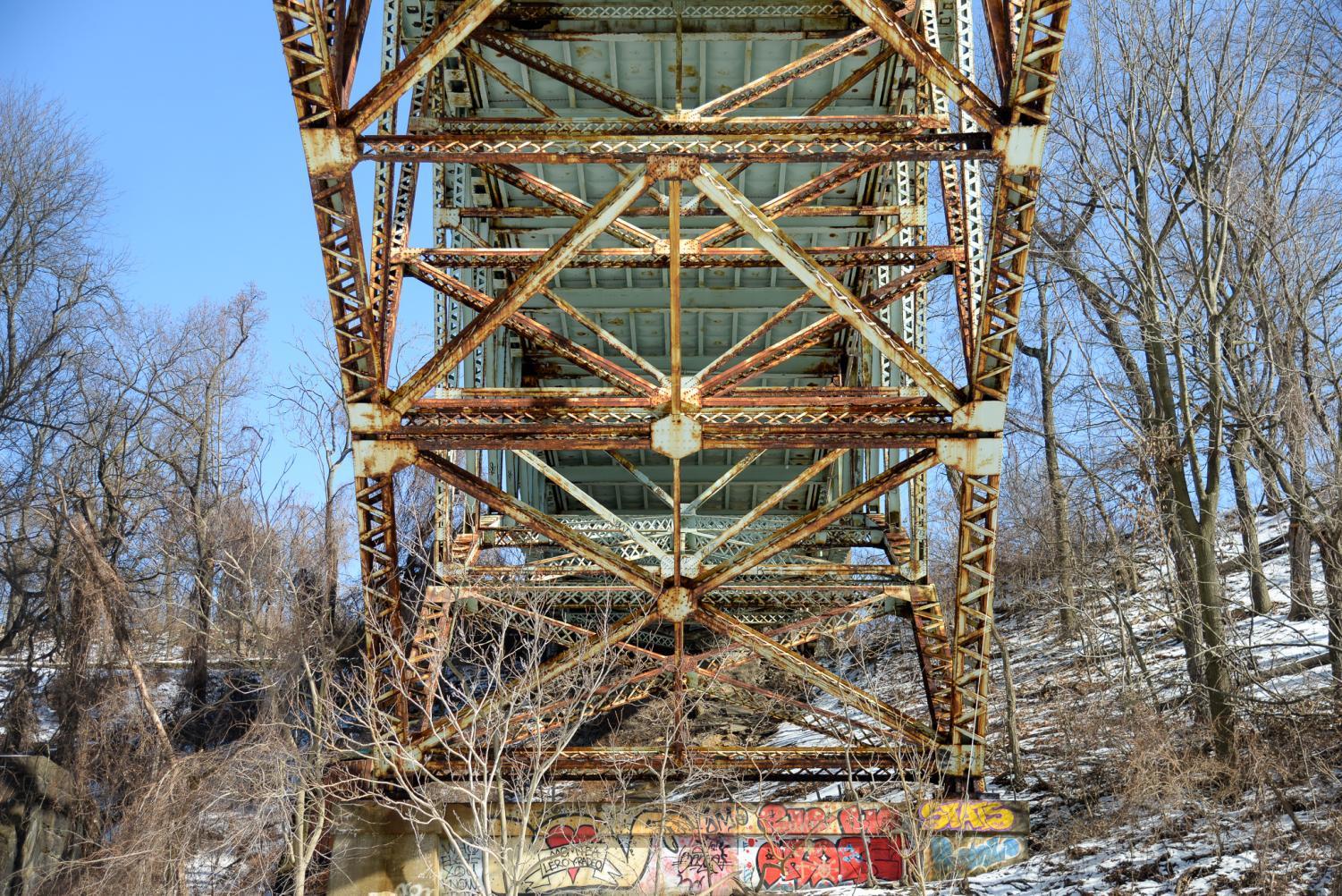‘Concerning’: Anderson Bridge in Oakland plagued by ‘poor’ ratings for nearly a decade


The underside of the Charles Anderson Bridge.
Soaring high above Junction Hollow, the Charles Anderson Bridge ferries more than 20,000 vehicles between Oakland and Schenley Park every day. The historic bridge, which spans nearly 800 feet along the Boulevard of the Allies, has been a major artery for travel since it was built in 1938.
But as recently as 2018, inspectors deemed the bridge “structurally deficient.” It is among Pittsburgh’s most dilapidated bridges, receiving “poor” ratings in the National Bridge Inventory, a federal database, since 2012. As Pittsburgh politicians debate infrastructure spending, preliminary planning is underway to rehabilitate the bridge, with construction anticipated to begin in 2025.
Kent Harries, a professor of civil engineering at Pitt, said the bridge’s poor condition is “concerning,” but not “terribly surprising.”
“We’ve got an old structure that really hasn’t received the maintenance that it needs,” Harries said. “It is just one of many neglected structures in the City, the county, the state, the country.”
Despite Harries’ concerns, he believes the bridge “doesn’t pose an immediate threat” to people’s safety.
State records show Allegheny County is home to 175 bridges rated in “poor” condition, a fact thrust into the national spotlight when the Fern Hollow Bridge in Frick Park collapsed last Friday, injuring 10 people and stranding seven vehicles. The collapse occurred hours before President Joe Biden arrived in Pittsburgh to tout his $1.2 trillion infrastructure package, and brought new attention to the Steel City’s now 445 bridges that span rivers, highways and valleys.
Local elected officials, including Mayor Ed Gainey, announced several infrastructure initiatives on Tuesday in response to the collapse. One will form a commission to provide advice on best practices for short- and long-term infrastructure investments. Another will require the City to publicly release more information about City-maintained infrastructure, such as an inspection history and risk factors. Corey O’Connor, who represents Council District 5, which borders on the Anderson Bridge, introduced legislation to implement the initiatives.
The Anderson Bridge has long earned attention from community members and local politicians for its deficiencies, according to Andrea Boykowycz, the assistant director for the Oakland Planning and Development Corp.
“Oakland residents have voiced concerns about the safety of Anderson Bridge for decades,” Boykowycz said in an email. “But the community wasn’t really alerted that there’s significant structural fatigue in the bridge until 2017.”
According to the latest data from the Pennsylvania Department of Transportation, the bridge’s substructure and superstructure are in “poor” condition and the deck is in “fair” condition.
An October 2018 inspection found the condition of the structure and deck to be “intolerable,” and recommended “corrective action” for the structure and a replacement for the deck. The bridge had remained in “fair” condition since the ‘90s before slipping to “poor” in October 2012. The federal bridge database listed an estimated rehabilitation cost of about $16.3 million for the bridge.
Boykowycz said the bridge’s “deficiencies” extend beyond a deteriorating structure. The sidewalks are too narrow, she said, and because of the bridge’s design, traffic tends to speed up as it enters the bridge — in both directions.
The City has been working for several years on a path forward for the bridge, which was first rehabilitated in 1987. The Department of Mobility and Infrastructure, along with engineering consultants from Michael Baker International, held two public meetings in September 2019 to discuss project timelines and collect community feedback.
Pittsburgh’s current capital budget shows that the City intends to spend about $23.6 million through 2026 to repair the bridge. The budget includes about $7.25 million for bridge repairs across the City in 2022.
City officials ultimately decided to move forward with rehabilitating the bridge instead of fully replacing it, according to a January presentation posted to a City website. The advantages to this option, according to the presentation, include less impact to the right of way and Schenley Park, improved lane configuration for Port Authority buses as well as separate, protected lanes for bikes, pedestrians and traffic.
The presentation said the project’s next steps are to hold a public meeting and complete environmental clearance by the end of 2022, finish design work by 2023 and then complete other pre-construction steps before construction kicks off in 2025.
When asked whether construction should be expedited for local bridges in “poor” condition, mayoral spokesperson Sam Wasserman referred The Pitt News to a Tuesday announcement from Mayor Gainey about the new infrastructure commission and reporting initiatives for the City’s aging bridges.
O’Connor said in a Tuesday interview that he thinks “all timelines should be sped up” for bridge projects. He added that it is important for a body like the proposed commission to provide outside input on the City’s infrastructure.
“[We’re] putting a commission together of experts to come to City Council with budgetary requests. And it takes the politics out of it,” O’Connor said. “Whatever that concern might be, from an expert commission to come and tell us that, is going to go a long way.”
Pittsburghers looking for “poor” bridges don’t have to venture far — there are 29 within Pittsburgh, about 7% of all bridges within city limits. The Boulevard of the Allies, a major thoroughfare with upgrades expected to start this year, is checkered with bridges in “poor” condition — seven of its 13 bridges in the route from Schenley Park to Downtown fall into the category.
As Biden surveyed the wreckage in Frick Park last Friday, he said he “didn’t realize there are more bridges in Pittsburgh than any other city in the world.” He added that “we are going to fix them all.”
The president’s $1.2 trillion infrastructure package includes $1.6 billion for Pennsylvania bridges, but PennDOT told the Pittsburgh Post-Gazette in mid-January that the state hasn’t decided which bridges will receive the money. PennDOT spokesperson Alexis Campbell did not respond to a request for comment Tuesday about whether the state has finalized its list of funded projects.
O’Connor said the Fern Hollow collapse was a “scary thing for all of us,” and thinks it sheds light on underlying infrastructure issues seen across the City and country.
“If you’re worried about driving on bridges now, I think you’re going to see a bump up in inspections, a bump up in safety conversations, in order to make sure that this doesn’t happen in the future,” O’Connor said. “Right now, in analyzing this, putting … new eyes on these situations, we can come to determinations whether the bridges need to be open, closed temporarily, rehabbed, rebuilt, whatever that might be.”
Harries said he encourages people to think about the nation’s infrastructure problems as “systemic,” adding that a “paradigm shift in society” is needed to fully address the deficiencies.
“We need to recognize that it is not one bridge. It is not a series of bridges. It's not one road,” Harries said. “Our nation, our society, certainly our commerce is founded on infrastructure. Not one piece of it. But all of it.”
Recent Posts
Porch roof collapse injures dozens during party on Semple Street
The roof of a porch on Semple Street collapsed during a St. Patrick’s Day celebration…
A Good Hill to Die On // Break It Down
In this release of “A Good Hill to Die On,” I dive deep into the…
Who Asked? // Does growth only “count” if it’s quantifiable?
This installment of Who Asked? by staff writer Brynn Murawski wonders why it feels like…
“They’re throwing trans people under the bus”: Counseling center faces backlash after event name change
On Feb. 24, Pitt’s Counseling Center faced backlash after briefly renaming an event from "LGBT…
Q&A: Meet the 2024-2025 SGB president and vice president
SGB announced the 2024-2025 election results at their meeting on Tuesday. The Pitt News spoke…
Editorial | Pitt Administration must listen to its students’ electoral demands
The passing of these referendums does not guarantee a future Pitt with these policies. Merely,…

